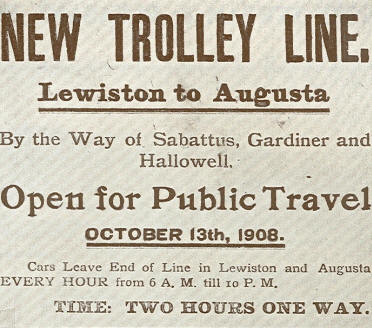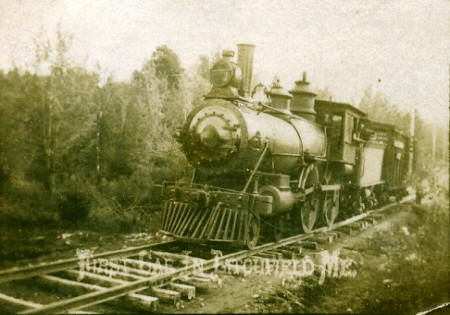|
Travel And Transportation
|
|
| When Eliphalet Smith brought
his family from Topsham there were no roads through the wilderness.
He came in midwinter with four pair of oxen drawing rude sledges
loaded with his household and farming tools, a wife and four
children - to a cabin in the southern part of town which he
presumably had built beforehand while hunting in the area.
Many years later his son John wrote the first road "of any extent"
in town was the one leading from the Corner to Purgatory Mills.
It was a long time after settlement before cart wheels were in use,
John said. In 1805 William Gay had only a blazed trail when he rode horseback from Gardiner for a two-bushel bag of "toll grain" from the Purgatory grist mill. As late as 1836 roads were still few and poor. Benjamin Berry, grandson of Captain Nathaniel, said "The nearest highway was on the east side of Pleasant Pond. There were only bridle paths or trails within miles of our place [on the present Pond Road] and these led to a rough sort of road and then across by ferry to Peacock's Tavern where it struck the stage road to Gardiner and Augusta." In 1820 Robert H. Gardiner, a determined promoter of canals for transport, utilized Cobbossee Stream in hauling granite from his Litchfield quarry to Gardiner to build Christ Church. The stone was taken down the stream in scows towed by horses or oxen. At the shallow, swampy end of Pleasant Pond a by-pass canal was dug to ease passage of the heavily loaded barges into the stream at the outlet of the pond. By 1840 "mail coaching entered its palmist days, and four- and six-horse trams crowded with passengers ran daily between Portland and Augusta, passing through Litchfield and West Gardiner." At the end of the 1800's a little steamer travelled Cobbossee Stream to and around Pleasant Pond for the convenience of vacationers and tourists from as far away as Boston. A few years later inboard motor boats appeared on the pond and stream. From 1908 to 1932 a street railway, named the Androscoggin and Kennebec in its later years, crossed town on its way between Lewiston and Waterville. The "electrics" carried Litchfield people on shopping, pleasure and business trips to the towns and cities on its route; the cars also carried - especially during World War I - a good deal of freight. After 1900 a regular stage route from Litchfield arrived in Augusta at 9:15 a.m. and left for the return trip at 4:00 p.m. source: Litchfield Yesterdays
|
|
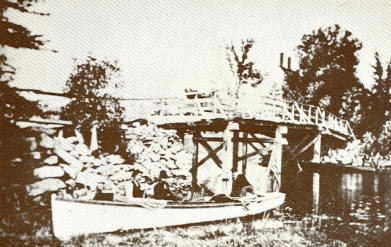 A Motorboat At The Pond Road - Cobbossee Stream Bridge
|
During the early 1900's
inboard motorboats provided travel on Cobbossee Stream and the
ponds. Low power "kicker" outboard engines replaced the first
crude engines during the middle 1900's. source: Litchfield Yesterdays |
 The Thoroughfare Bridge In The Early 1900's
|
|
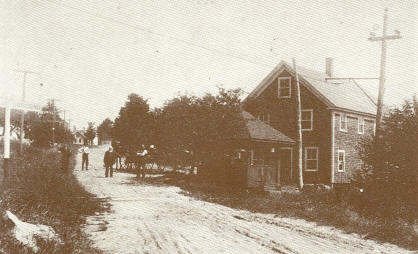 Bachelder's Corner Crossing Of The Trolley Line, About 1912
|
The waiting station and
Condon's store. source: Litchfield Yesterdays |
| Sand Pond is barely visible
through the trees at the left. The car is on its way west
toward Lewiston. source: Litchfield Yesterdays |
 Holiday-Makers Arriving At Tacoma Inn By The "Electrics"
|
|
The Androscoggin And Kennebec Street Railway
|
The line, originally named the
Lewiston, Augusta and Waterville Street Railway, ran 3.6 miles
through Litchfield from the Woodbury-Sand Pond Thoroughfare to the
West Gardiner line near Horseshoe Pond, following for most of the
way the present Highway 126. The trolley line was opened in
1908 and reorganized as the Androscoggin and Kennebec in 1919.
It provided both passenger and freight service until 1932. "During the best years of the road, from late 1909 until 1918, a regular hourly schedule was maintained." Passengers paid fares by zones, of which there were 20 in all. The Tacoma Inn was at the 6th fare (zone) limit, Dennis Hill at the 7th and Spear's Corner at the 8th. The beginning fare of five cents a zone was increased to seven cents in 1918, to nine cents in 1920 and finally to ten cents in 1924. source: Litchfield Yesterdays
|
|
Photo Caption: "First Car In Litchfield, Me" |
Note that 2008 was the 100th anniversary of the Lewiston to Augusta trolley line ! The only rail line known to have ever existed in Litchfield was the trolley line that ran from Gardiner, through Litchfield, to Sabattus. It was owned by the Lewiston, Augusta and Waterville Street Railway. The photo here was POSSIBLY taken in 1907 or 1908 during construction of the trolley line. It appears the track under and behind the engine has been completed while the track in front of the engine is still under construction, lacking some ties and ballast between them. Two people are visible in the photo, one leaning from the cab and another standing beside the track at the end of the train. It also appears three poles are visible behind the train, possibly intended to support power lines for the trolley. source: Ed Avis |
| In the 1890's the sea-going steamboats Kennebec and Sagadahoc of the Kennebec Steamboat Company, Boston, provided regular service up the Kennebec to head of tide. Tourists and campers left Boston in the evening and arrived at Gardiner early the next morning. There they took the little steamer Glenn, operated by Captain George A. Olive and berthed at the New Mills bridge, for a trip up Cobbosseecontee Stream and around Pleasant Pond. Some visitors camped in tents on the shores where there was abundant wood and spring water, and where fresh milk, bread, butter and eggs could be bought from nearby farms. At that time there were only thirteen cottages scattered along the shores of the pond. By 1960 the Town Report counted 203 private cottages around the shores of Litchfield's eight ponds and Cobbossee Stream. source: Litchfield Yesterdays
|
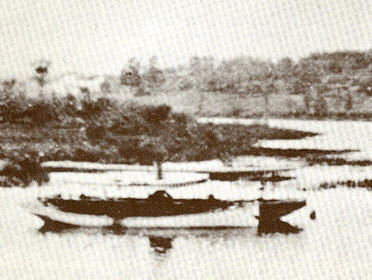 Steamer "Glenn" |
